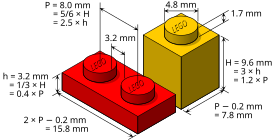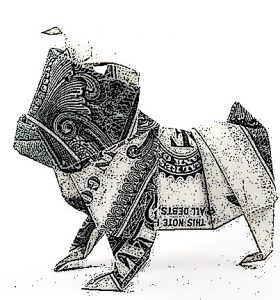 As The LEGO Group celebrates its 80th Birthday, we take a look back at its history with this short animated film. Check out this short, animated film about the LEGO Group history from 1932 to 1968 😀
As The LEGO Group celebrates its 80th Birthday, we take a look back at its history with this short animated film. Check out this short, animated film about the LEGO Group history from 1932 to 1968 😀

About Lego
Lego (trademarked in capitals as LEGO) is a popular line of construction toys manufactured by The Lego Group, a privately held company based in Billund, Denmark. The company’s flagship product, Lego, consists of colorful interlocking plastic bricks and an accompanying array of gears, minifigures and various other parts. Lego bricks can be assembled and connected in many ways, to construct such objects as vehicles, buildings, and even working robots. Anything constructed can then be taken apart again, and the pieces used to make other objects. Lego began manufacturing interlocking toy bricks in 1949, since which a global Lego subculture has developed, supporting movies, games, competitions, and five themed amusement parks.

The Lego Group began in the workshop of Ole Kirk Christiansen (7 April 1891 – 11 March 1958), a carpenter from Billund, Denmark, who began making wooden toys in 1932. In 1934, his company came to be called “Lego”, from the Danish phrase leg godt, which means “play well”.

It expanded to producing plastic toys in 1947. In 1949 Lego began producing the now famous interlocking bricks, calling them “Automatic Binding Bricks”. These bricks were based largely on the patent of Kiddicraft Self-Locking Bricks, which were released in the United Kingdom in 1947. Lego modified the design of the Kiddicraft brick after examining a sample given to it by the British supplier of an injection-molding machine that the company had purchased. The bricks, originally manufactured from cellulose acetate, were a development of traditional stackable wooden blocks that locked together by means of several round studs on top and a hollow rectangular bottom. The blocks snapped together, but not so tightly that they required extraordinary effort to be separated.

The Lego Group’s motto is det bedste er ikke for godt which means roughly ‘only the best is the best‘ (more literally ‘the best is never too good’). This motto was created by Ole Kirk to encourage his employees never to skimp on quality, a value he believed in strongly. The motto is still used within the company today. By 1951 plastic toys accounted for half of the Lego Company’s output. Despite this fact, the Danish trade magazine Legetøjs-Tidende (Toy-Times) stated at the beginning of the 1950s, after having visited the Lego factory in Billund, that ‘plastic would never be able to replace good and honest wooden toys. This outcry demonstrates fittingly how most people felt (and sometimes still feel) towards the use of plastic in toys. Lego toys, however, seem to be an exception to the dislike of plastic toys due to the high standards set by Ole Kirk.

By 1954, Christiansen’s son Godtfred Kirk Christiansen had become the junior managing director of the Lego Group. It was his conversation with an overseas buyer that struck the idea of a toy system. Godtfred saw the immense potential in Lego bricks to become a system for creative play but the bricks still had some problems from a technical standpoint: their locking ability was limited and they were not very versatile. In 1958, the modern brick design was developed but it took another five years to find the right material for it, ABS (acrylonitrile butadiene styrene) polymer. The modern Lego brick was patented at 1:58 P.M. on 28 January 1958; bricks from that year are still compatible with current bricks.
Design
Lego pieces of all varieties comprise a universal system. Despite variation in the design and purpose of individual pieces over the years, each remains compatible in some way with existing pieces. Lego bricks from 1958 still interlock with those made in the current time, and Lego sets for young children are compatible with those made for teenagers.
Each Lego piece must be manufactured to an exacting degree of precision. When two pieces are engaged they must fit firmly, yet be easily disassembled. The machines that make Lego bricks have tolerances as small as 10 micrometers.[6]

Dimensions of some standard Lego bricks and plates.
Primary concept and development work takes place at the Billund headquarters, where the company employs approximately 120 designers. The company also has smaller design offices in the UK, Spain, Germany, and Japan, which are tasked with developing products aimed specifically at these markets. The average development period for a new product is around twelve months, in three stages. The first stage is to identify market trends and developments, including contact by the designers directly with the market; some are stationed in toy shops close to holiday periods, while others interview children. The second stage is the design and development of the product based upon the results of the first stage. As of September 2008 the design teams use 3D modeling software to generate CAD drawings from initial design sketches. The designs are then prototyped using an in-house stereolithography machine. These are presented to the entire project team for comment and for testing by parents and children during the “validation” process. Designs may then be altered in accordance with the results from the focus groups. Virtual models of completed Lego products are built concurrently with the writing of the user instructions. Completed CAD models are also used in the wider organization, such as for marketing and packaging

Manufacture
Since 1963, Lego pieces have been manufactured from a strong, resilient plastic known as acrylonitrile butadiene styrene (ABS). As of September 2008, the engineers use the NX CAD/CAM/CAE PLM software suite to model the elements. The software allows the parts to be optimized by way of mold flow and stress analysis. Prototype molds are sometimes built before the design is committed to mass production. The ABS plastic is heated to 232 °C (450 °F) until at a dough-like consistency. It is then injected into the molds at pressures between 25 and 150 tons, and takes approximately 15 seconds to cool. The molds are permitted a tolerance of up to two micrometres, to ensure the bricks remain connected. Human inspectors check the output of the molds, to eliminate significant variations in color or thickness. According to the Lego Group, about eighteen bricks out of every million fail to meet the standard required.Lego factories recycle all but about 1 percent of their plastic waste from the manufacturing process every year. If the plastic cannot be re-used in Lego bricks, it is processed and sold on to industries that can make use of it.

Manufacturing of Lego bricks occurs at a number of locations around the world. Molding is done in Billund, Denmark; Nyíregyháza, Hungary; and Monterrey, Mexico. Brick decorations and packaging is done at plants in Denmark, Hungary, Mexico and Kladno in the Czech Republic. The Lego Group estimates that in the course of five decades it has produced some 400 billion Lego blocks. Annual production of Lego bricks averages approximately 36 billion per year, or about 1140 elements per second. If all the Lego bricks ever produced were to be divided equally among a world population of six billion, each person would have 62 Lego bricks. According to an article in BusinessWeek in 2006, Lego could be considered the world’s No. 1 tire manufacturer; the factory produces about 306 million tiny rubber tires a year.

LEGO Group turns 80
In 1932, Ole Kirk Christiansen founded the LEGO Group. Today the company has approximately 10,000 employees, and it is the world’s third largest manufacturer of play materials.
The LEGO Group can look back onto an impressive success story: in 1932 Ole Kirk Christiansen founded a production company for wooden toys in the Danish city of Billund. His central idea was, “Only the best is good enough.” The motto stayed, but other than that, a lot changed. The company has moved from the originally small workshop back in 1932, to become the third largest producer of play materials in the world. It is currently represented in more than 130 countries with approx. 10,000 employees. The name “LEGO” comes from the two Danish words “leg” and “godt”, which translates to “play well”.
The success story of the LEGO brick
The triumph of the LEGO Group started almost fifteen years after the foundation of the company, when Ole Kirk Christiansen discovered that plastic was the ideal material for toy production. At the end of the 1940s, the first bricks hit the market, which resemble the modern classic of today. In 1958 Christiansen perfected the LEGO brick with the familiar knobs-and-tubes-connecting-system, which is what the now 3120 different LEGO elements are still based on. LEGO bricks can be combined in an endless variety of combinations in continuously new ways. For six bricks of the same color with 2X4 studs alone, there are 915 million combination possibilities. The imagination has therefore no boundaries.
Since 1962, LEGO bricks are made of acrylonitrile-butadiene-styrene-copolymer – short: ABS. This matte-gloss plastic is very hard and has a scratch- and bite- proof surface. The LEGO basic material is also completely safe. For toddlers who like putting their toys in their mouth or biting on them, the material is perfectly suitable – especially the LEGO DUPLO® bricks, which are twice as big as the normal LEGO bricks and therefore cannot be swallowed.
From small to big: Building fun for every LEGO fan
In addition to the classic LEGO brick sets, the LEGO Group has over 25 product lines in their range. The product lines of LEGO DUPLO and City, with their realistic themes, like zoo, police or fire department stations, are especially made for preschool and primary school children. Boys aged seven and up can dive into different fantasy worlds whether it’s with the LEGO The Lord of the Rings™ or the galactic LEGO Star Wars™ Sets or with the action-packed, Asian themed, Ninjago characters. Technic enthusiastic children from around age nine will find the MINDSTORMS and Technic sets interesting.
Not only children but also adults enjoy tricky construction challenges of the Technic and Architecture sets or the exclusive items such as the LEGO VW T1 camping bus.
In 2009 LEGO Games was introduced, inviting families with children aged five or older to enjoy a new dimension of LEGO fun with board games. With the buildable LEGO dice and the changeable game board (made out of classic LEGO elements), each game can be played in a different way. Another new product is LEGO Life of George a mobile game merging bricks and augmented reality.
The newest & most successful product launch to date is LEGO Friends, a line focusing on friendship between five girls. The products are successfully combining building and role play around the themes of nature, sport, music, and animals.
Creativity, Quality, and Building-fun guaranteed for generations
Whether playing with a bicycle, spaceship or train station, the values of creativity, fun, quality, learning and care apply to all LEGO products and services. These values and the LEGO brick are the heart of the LEGO Brand and are continuously brought to life in our product development, and shared with kids around the world. Hopefully someday they will share their LEGO childhood play experience with their children.
Source : http://aboutus.lego.com/en-us/news-room/2012/august/lego-group-80-years/

Find out more here, http://www.facebook.com/LEGOGROUP
Source: Lego Wiki
[tags]Lego, Toys, Entertainment , ABS ,acrylonitrile butadiene styrene, Lego Story, Ole Kirk Christiansen , 3d animation, toy story, Lego Group, collectibles, toy history[/tags]



